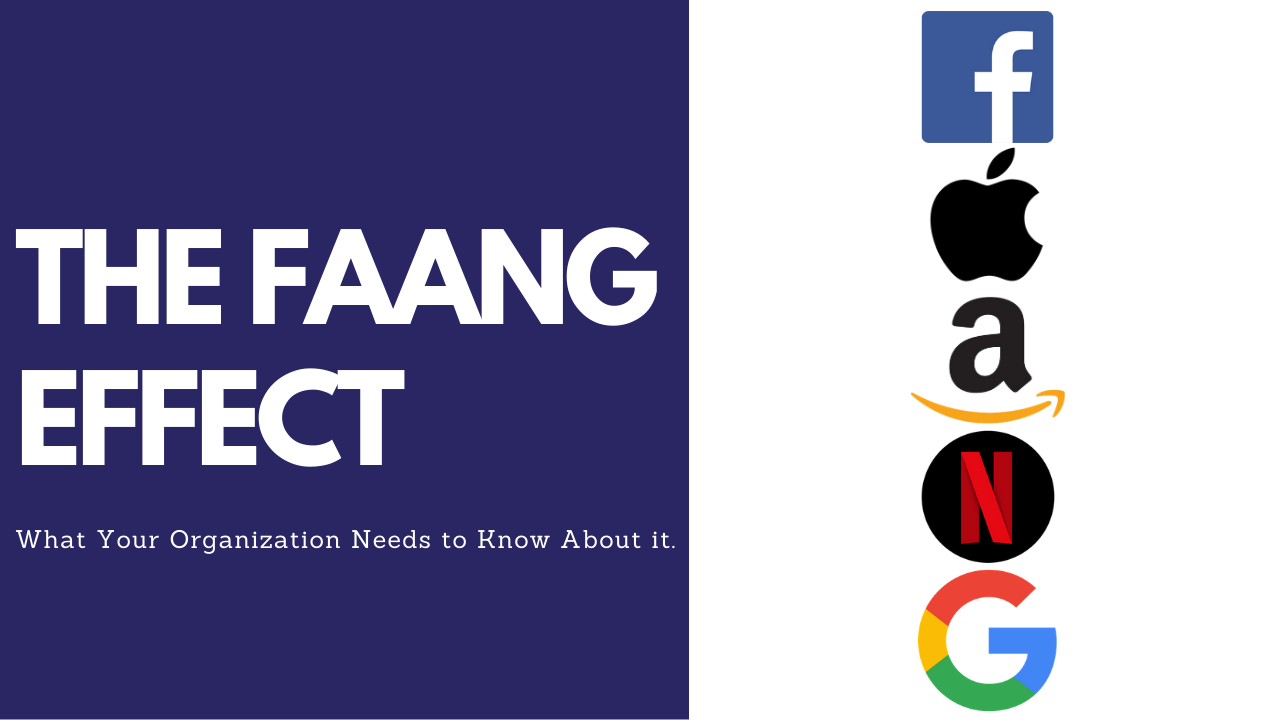What Your Organization Needs To Know About The FAANG Effect
I would like to address the issue which I dub the FAANG effect, a result of copying the FAANG companies.
By FAANG companies, it’s an acronym for, Facebook, Apple, Amazon, Netflix, and Google.
It’s a term that comes from the investment world as these are some of the highest performing tech companies in the world.
You can slot some other large tech organizations in here as well, like Microsoft, Twitter, and LinkedIn. However, FAANG has a nice ring to it, hence we end up with these five FAANG companies.
Want this post in video form? Check out our YouTube channel!
These FAANG companies have set a benchmark in many ways, and not just with their products and services.
They’ve had measurable impacts on how and what organizations offer for benefits and perks, the recruiting and interview process, onboarding processes, the employee experience, and what they do about employee engagement.
Many look to these organizations to see how the future of work will look like See my thoughts on the future of work here.
As a result, these FAANG companies are constantly emulated and copied, for better or for worse, resulting in the FAANG effect.
While the FAANG companies tend to (mostly) be customer-obsessed, their employee experience can leave a lot to be desired. The employee experience is greatly sacrificed in order to appease customers any ways possible, resulting in high turnover:
I’ve written about this, and why this can be detrimental to your organization.
Of course, these FAANG companies have people ready to sell their soul and their firstborn just for a chance to work there.
As a result, they’re willing to overwork themselves at these organizations, who are more than happy to fill those positions again should they leave. We’ve written about the dangers of overwork culture that these kind of organizations promote here.
Some of the FAANG companies (like Netflix) have had their employee handbook out in the open (while dated, here is one from Netflix in 2009). There are a number of books that are written from insiders at these organizations that you find on a number of lists for books to read on corporate culture (but not here at Playficient – check out our list of recommended corporate culture books here).
Plenty of smaller organizations will look at these FAANG companies and think to themselves:
Hey, this works for them, so let’s do the same thing!
Organizations then try to cop the same kind of onboarding experience, the recruiting processes, thinking that it’s going to magically work out for them.
It’s like taking DNA from another, and trying to splice it into yourself. That sounds silly, doesn’t it? Yet, many organizations try to do this without realizing:
- Why organizations do so.
- Why it works for them.
I want you to avoid this. It’s such an important point, it’s featured in the Playficient Workplace Culture Manifesto.

Source: Pixabay
1. The FAANG Effect/Dark Knight/Game Of Thrones/Grunge Effect.
The issue with the FAANG effect is when organizations blindly copy what other organizations (typically the FAANG companies) are doing, without understanding the WHY behind it. They get so caught up in the details and don’t realize why they work. There’s a quote I used in a previous post I did for onboarding that comes from Jeff Bezos of Amazon (one of the FAANG companies):
We are stubborn on vision. We are flexible on details.
Again, organizations get so caught up on the details and not the vision behind it. They fail to see what these organizations have put what they do into place.
Outside the frame, is what we’re leaving out.
“Go With The Flow”, Queens Of The Stone Age
Who knows how many organizations have tried to copy Google’s interview process, making people go through an 18.5 part interview process, even if their organization has less than 50 people? Do they understand WHY Google does that for their interview process? At this point, does Google even understand?
A few years ago, Google removed their infamous brain teaser questions from their interviews.
How many organizations try to do the same thinking it will boost their employee engagement (a topic that I’ve written about in the past), but it ends up falling flat? This point comes up again in a post I wrote about how to use design thinking to improve the employee experience. By all means be influenced, but don’t just blindly copy!
If you only read the books that everyone else is reading, you can only think what everyone else is thinking.
Haruki Murakami
There are other examples of the FAANG effect that manifest themselves in other forms across different walks of life.
For example, let’s take a look at the 2008 film The Dark Knight, in what we will call “The Dark Knight Effect”. Googling that brought up results like the following:
- The Dark Knight Effect
- The Dark Knight’ Effect: 15 Blockbusters Influenced by Christopher Nolan Over the Last 10 Years
I recently rewatched The Dark Knight for the first time in years. Still a damn great film. The problem is so many films (and not just DC comic films) try to copy the surface level aspects of The Dark Knight, and they more or less have all failed. Since 2008, so many films have tried to cop aspects from The Dark Knight and completely miss the point.
The Dark Knight was so well received for the sum of its parts, from how it examined themes, its pacing, its excellent screenplay, directing, and the cast, while so many films tried to copy just the parts, and didn’t get anywhere near it. Ten + years later, studios are still trying to find that magic formula, but they seem to ignore what made the film work.
Studios are willing to spend hundreds of millions of dollars, yet next to no film projects have turned into what The Dark Knight was. Again, it’s a sum being greater than the parts.

Film Executives. Source: Firehouse Theatre
For another example, look at something like Game of Thrones.
*MAY 2019 UPDATE: Well, after that last season, I hope more realize how not to end a show.*
Look at how much it has had an impact on the world of TV. There’s been many shows that have popped up in its wake that are heavily influenced by it, but none have been able to reach it.
Some think that it’s all about the violence and nudity, and that’s all you need to make a great show. But it misses what makes the show, and especially the books, hit such a mark. It goes far beyond that (even if, in this writer’s opinion, the show has lost the mark for a few seasons now, after running out of book material).
Look at all the grunge imitators that popped up in the 90s.
A lot of bands tried to copy from the big four of grunge:
- Pearl Jam (the most widely copied)
- Nirvana
- Alice and Chains
- Soundgarden

It’s a bummer that only Pearl Jam still has its frontman alive. Source: Consequence of Sound
Yet none of them really seemed to understand why those bands worked. They thought that having enough fuzz effect on their guitars and wearing flannel was enough. Again, they copied the surface level, and not what made those bands work (hint: it may or may not have to do with their songwriting chops).
2. What You Should Do If Your Company Worships What The FAANG Companies Do, Or Fall Victim To The The FAANG Effect.
I want to be clear that it’s very possible that your organization does not deal with the FAANG effect. However, if you’re looking to work on your employee engagement, your onboarding process, your employee journey map, it’s easy to start looking around and see what others are doing. Google searches love on these topics love to bring up the FAANG companies as the top results.
You might be tempted to just do the same, and jamming it into your organization without understanding the why.
The FAANG companies do what they do as it ties with their values. It’s something that they have worked on and tinkered with for a number of years, and continue to improve.
To help demonstrate this, let’s take a look at the organization F5 Networks.
Haven’t heard of them? Neither have I, until recently. In 2014, they were placed fourth in Glassdoor’s best places to work. However, it doesn’t have any of the perks and benefits that the FAANG companies have. People work 9-5, and work in cubicles. It goes against what the FAANG companies use and promote for an engaging workplace, yet it has extremely high ratings and CEO approval. Looking at this article from INC, You Don’t Need Fancy Perks to Be a Best Place to Work, you can see it has focused on a solid foundation with the following:
- Focusing on their seven values.
- An open and transparent system amongst employees. This is backed up with an extremely high CEO approval on Glassdoor.
- Employees listen and incorporate employee feedback. I’ve talked about this in a previous post and how few organizations actually follow through with this, if they even do surveys.
- A strong mentoring and collaboration setup.
- A recognition and award system.
Now, I’m sure all the FAANG companies and FAANG-minded organizations have the above (or at least claim they do), but some may not be as focused on them like F5 Networks are, and instead get caught up with the flash. It’s an example of an organization that gets employee engagement right, and doesn’t need to rely on flashy benefits and perks that a lot of organizations try to use to boost employee engagement (which I’ve written on in the past).

Also a solution for creating an engaging workplace without all the fancy perks.
Conclusion
In the end, you need to do what works for you and your organization. Don’t let the FAANG effect cloud your judgement. You do you. Not what the FAANG companies are doing, or what your competitors are doing. Your organization is who they are by their values and their DNA. By all means, look at what others are doing, but realize why that works for them.
If you don’t, you’ll end up falling for the FAANG effect.
To end off with another quote from Jeff Bezos:
“We never claim that our approach is the right one — just that it’s ours — and over the last two decades, we’ve collected a large group of like-minded people.”
Feeling that your organization deals with the FAANG effect?
At Playficient, we can help get that stench off that’s not allowing your organization to reach its full potential. Our three core offerings for organizations are as follows:
Please contact us should you have any questions.


